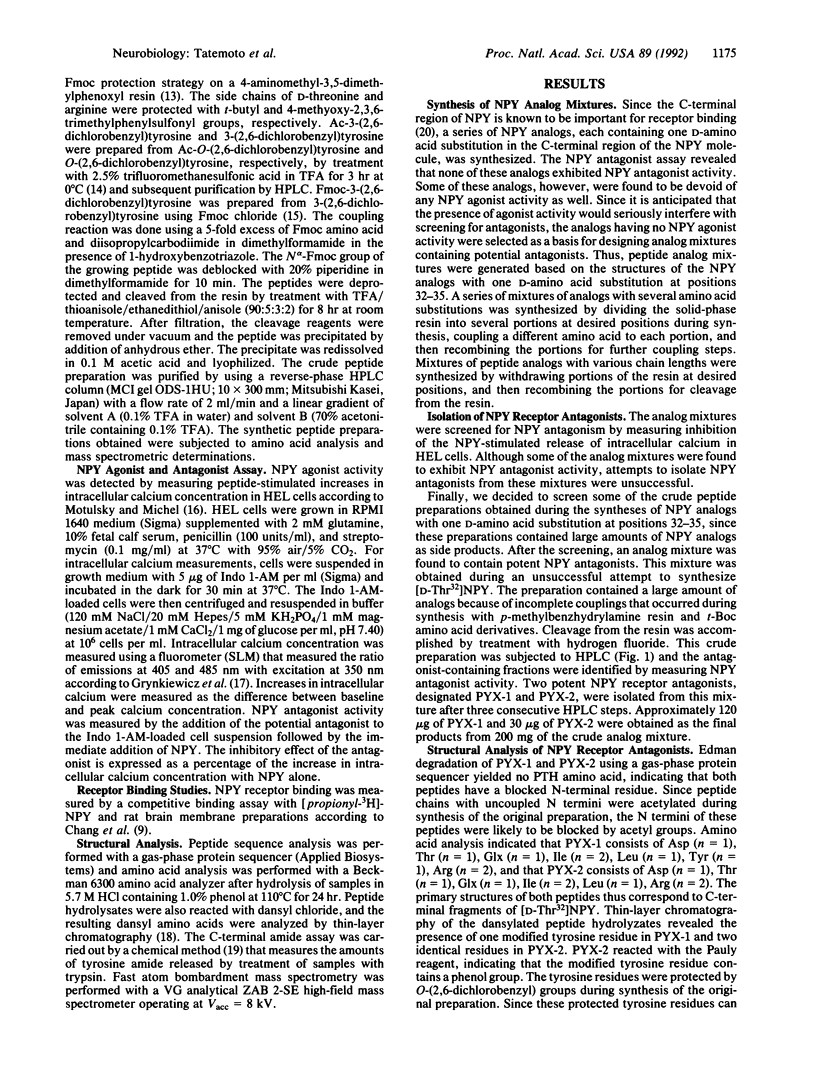Abstract
We report the synthesis of receptor antagonists of neuropeptide Y (NPY) by a strategy based on synthesis of mixtures of analogs and the subsequent isolation and identification of receptor antagonists from these mixtures. After screening a series of mixtures of NPY analogs by using an NPY antagonist assay, two potent receptor antagonists, designated PYX-1 and PYX-2, were isolated from an antagonist-containing mixture. Structural analysis revealed these analogs to be Ac-[3-(2,6-dichlorobenzyl)Tyr27, D-Thr32]NPY-(27-36) amide and Ac-[3-(2,6-dichlorobenzyl)Tyr27,36,D-Thr32]NPY-(27-36) amide, respectively. The receptor antagonists inhibited release of intracellular calcium elicited by NPY in human erythroleukemia cells and displaced 3H-labeled NPY from NPY receptors in rat brain membrane. The approach of screening and identifying useful analogs from synthetic mixtures may significantly reduce the time and resources previously required for development of receptor antagonists.
Full text
PDF




Selected References
These references are in PubMed. This may not be the complete list of references from this article.
- Albericio F., Barany G. An acid-labile anchoring linkage for solid-phase synthesis of C-terminal peptide amides under mild conditions. Int J Pept Protein Res. 1987 Aug;30(2):206–216. doi: 10.1111/j.1399-3011.1987.tb03328.x. [DOI] [PubMed] [Google Scholar]
- Balasubramaniam A., Sheriff S. Neuropeptide Y (18-36) is a competitive antagonist of neuropeptide Y in rat cardiac ventricular membranes. J Biol Chem. 1990 Sep 5;265(25):14724–14727. [PubMed] [Google Scholar]
- Boublik J. H., Spicer M. A., Scott N. A., Brown M. R., Rivier J. E. Biologically active neuropeptide Y analogs. Ann N Y Acad Sci. 1990;611:27–34. doi: 10.1111/j.1749-6632.1990.tb48919.x. [DOI] [PubMed] [Google Scholar]
- Chang R. S., Lotti V. J., Chen T. B. Specific [3H]propionyl-neuropeptide Y (NPY) binding in rabbit aortic membranes: comparisons with binding in rat brain and biological responses in rat vas deferens. Biochem Biophys Res Commun. 1988 Mar 30;151(3):1213–1219. doi: 10.1016/s0006-291x(88)80495-9. [DOI] [PubMed] [Google Scholar]
- Doughty M. B., Chu S. S., Miller D. W., Li K., Tessel R. E. Benextramine: a long-lasting neuropeptide Y receptor antagonist. Eur J Pharmacol. 1990 Aug 21;185(1):113–114. doi: 10.1016/0014-2999(90)90218-u. [DOI] [PubMed] [Google Scholar]
- Erickson B. W., Merrifield R. B. Acid stability of several benzylic protecting groups used in solid-phase peptide synthesis. Rearrangement of O-benzyltyrosine to 3-benzyltyrosine. J Am Chem Soc. 1973 May 30;95(11):3750–3756. doi: 10.1021/ja00792a046. [DOI] [PubMed] [Google Scholar]
- Grynkiewicz G., Poenie M., Tsien R. Y. A new generation of Ca2+ indicators with greatly improved fluorescence properties. J Biol Chem. 1985 Mar 25;260(6):3440–3450. [PubMed] [Google Scholar]
- Hartley B. S. Strategy and tactics in protein chemistry. Biochem J. 1970 Oct;119(5):805–822. doi: 10.1042/bj1190805f. [DOI] [PMC free article] [PubMed] [Google Scholar]
- Laburthe M., Chenut B., Rouyer-Fessard C., Tatemoto K., Couvineau A., Servin A., Amiranoff B. Interaction of peptide YY with rat intestinal epithelial plasma membranes: binding of the radioiodinated peptide. Endocrinology. 1986 May;118(5):1910–1917. doi: 10.1210/endo-118-5-1910. [DOI] [PubMed] [Google Scholar]
- Motulsky H. J., Michel M. C. Neuropeptide Y mobilizes Ca2+ and inhibits adenylate cyclase in human erythroleukemia cells. Am J Physiol. 1988 Dec;255(6 Pt 1):E880–E885. doi: 10.1152/ajpendo.1988.255.6.E880. [DOI] [PubMed] [Google Scholar]
- Tatemoto K., Carlquist M., Mutt V. Neuropeptide Y--a novel brain peptide with structural similarities to peptide YY and pancreatic polypeptide. Nature. 1982 Apr 15;296(5858):659–660. doi: 10.1038/296659a0. [DOI] [PubMed] [Google Scholar]
- Tatemoto K. Isolation and characterization of peptide YY (PYY), a candidate gut hormone that inhibits pancreatic exocrine secretion. Proc Natl Acad Sci U S A. 1982 Apr;79(8):2514–2518. doi: 10.1073/pnas.79.8.2514. [DOI] [PMC free article] [PubMed] [Google Scholar]
- Tatemoto K., Mutt V. Chemical determination of polypeptide hormones. Proc Natl Acad Sci U S A. 1978 Sep;75(9):4115–4119. doi: 10.1073/pnas.75.9.4115. [DOI] [PMC free article] [PubMed] [Google Scholar]
- Tatemoto K., Mutt V. Isolation of two novel candidate hormones using a chemical method for finding naturally occurring polypeptides. Nature. 1980 Jun 5;285(5764):417–418. doi: 10.1038/285417a0. [DOI] [PubMed] [Google Scholar]
- Tatemoto K. Neuropeptide Y and its receptor antagonists. Use of an analog mixture-screening strategy. Ann N Y Acad Sci. 1990;611:1–6. doi: 10.1111/j.1749-6632.1990.tb48917.x. [DOI] [PubMed] [Google Scholar]
- Tatemoto K. Neuropeptide Y: complete amino acid sequence of the brain peptide. Proc Natl Acad Sci U S A. 1982 Sep;79(18):5485–5489. doi: 10.1073/pnas.79.18.5485. [DOI] [PMC free article] [PubMed] [Google Scholar]
- Wahlestedt C., Yanaihara N., Håkanson R. Evidence for different pre-and post-junctional receptors for neuropeptide Y and related peptides. Regul Pept. 1986 Feb;13(3-4):307–318. doi: 10.1016/0167-0115(86)90048-0. [DOI] [PubMed] [Google Scholar]


